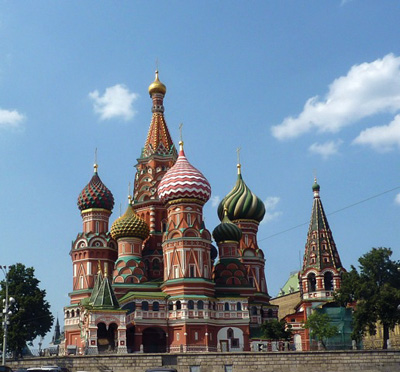
On a recent visit to Russia, I was amazed at the great number of
beautiful churches we encountered. From the imperial capital of St.
Petersburg, through the villages and cities along the canals,
rivers and lakes leading to the present capital of Moscow, onion
domes of every hue indicated the presence of Russians worshipping
God.
On a recent visit to Russia, I was amazed at the great number of beautiful churches we encountered. From the imperial capital of St. Petersburg, through the villages and cities along the canals, rivers and lakes leading to the present capital of Moscow, onion domes of every hue indicated the presence of Russians worshipping God.
Approximately 75 percent of the Russian population belongs to the Orthodox Church; although there are Protestants and Roman Catholics in the country, the second-largest faith group is Muslim.
In “The Orthodox Church,” Timothy Ware relates how Christianity came to Russia. Vladimir, the pagan Prince of Kiev, sent representatives to visit other countries and to report back to him about the religions they observed there. They witnessed Muslim and Catholic worship, but were unimpressed. Then they attended a Greek Orthodox service in Constantinople.
“We knew not whether we were in heaven or on earth, for surely there is no such splendor or beauty anywhere on earth,” said the representatives, according to the book. “We cannot describe it to you: only this we know, that God dwells there among men and that their service surpasses the worship of all other places. For we cannot forget that beauty.”
Thus, in the 10th century, Orthodoxy was made the official state religion of Russia. By the 18th century, the church had become almost a department of the Tsar’s government, so when the Communist Revolution occurred in 1917, the Bolsheviks began to dismantle the power of the church. Karl Marx famously called religion “the opiate of the people,” and atheism became mandatory for members of the ruling Communist Party.
Soon the government nationalized all church property, executed or persecuted clergy, and prohibited publication of religious materials. By 1940, the number of parishes had dropped from 54,000 to only 500.
During World War II, the government allowed increased practice of Christianity to improve the morale of the people, but when the war ended the Communists returned to religious persecution. Secret police agents infiltrated the clergy and made sure that the church supported Communist policies.
Since the fall of Communism, however, freedom of religion has been proclaimed in Russia. The government has returned the property confiscated earlier, even ancient cathedrals that had been preserved as museums. Orthodoxy is experiencing a growth in church attendance and enthusiasm, and even high government officials like Vladimir Putin make high-profile visits to worship services.
Russian Orthodox churches are quite distinctive. A prominent feature is the presence of large onion-shaped domes, numbering from one to more than 20, in striking colors. They are said to symbolize burning candles.
Orthodox church interiors are quite different from what most Americans are familiar with, being more often square than rectangular.
– There are no stained glass windows with images of saints nor any statues. Instead, there many are “holy icons,” paintings, frescoes and mosaics, “which bear witness to God’s kingdom on earth.” The pictures are not life-like representations, but use “line, form and color to show people, not as they appear to be, but as a reality transfigured by the power of God.”
– Russian churches generally use the “Slav Cross,” which has a shorter top horizontal bar symbolizing the inscription board, a longer horizontal bar where hands were nailed, and a short slanted bar representing the footrest.
– There is an “iconostasis,” a wall or screen covered with icons of Christ, saints or Mary, Mother of God, which separates the nave (where worshippers are) from the sanctuary (where the altar is located). The priest moves back and forth during the liturgy between the two areas via three doors.
– On the ceiling of the dome are usually painted many more icons.
– Despite liturgies that can last more than two hours, there are no pews, as worshippers stand for the service.
n When an Orthodox Christian enters a church, the general procedure is to buy a candle, go up to an icon, cross oneself, kiss the icon and light the candle in front of it while offering a prayer. Women always cover their heads when entering a church.
Those interested in seeing a classic-style Russian Orthodox Church don’t need to take a 15-hour flight to Europe. Holy Virgin Cathedral is located at 6210 Geary Blvd. in San Francisco; its towering onion domes can be seen from much of the Sunset District.









